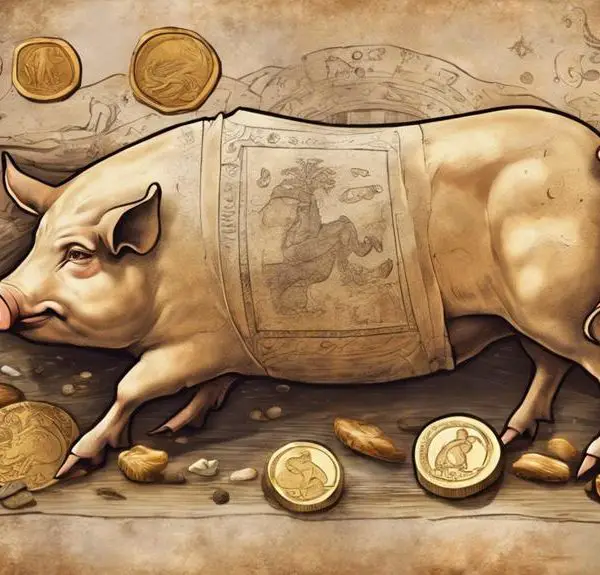Biblical narratives intertwine with the asp, revealing layers of symbolism and lessons in faith, danger, and redemption.

Asp in the Bible
As you wander through the ancient texts of the Bible, you'll encounter the asp, a serpent that slithers symbolically through its pages. This creature, often associated with danger and deceit, holds a deeper meaning within the scripture, embodying both the perils and the profound teachings that the texts offer.
From the Old Testament's stern warnings to the New Testament's metaphorical layers, the asp's presence invites you to explore the nuanced symbolism that has captivated scholars and believers alike. If you're intrigued by how this venomous entity intertwines with biblical lessons and prophetic visions of peace, there's much to uncover about its role and the messages it conveys.
Key Takeaways
- Asps symbolize deceit, danger, and the lethal consequences of sin in biblical texts.
- Their presence underscores the importance of moral vigilance and spiritual wisdom.
- The use of asp imagery in the Bible reflects the complex relationship between humans, their environment, and spirituality.
- Biblical references to asps serve as vivid warnings about the spiritual perils of disobedience and deceit.
Symbolism of the Asp

In biblical texts, the asp symbolizes deceit and danger, reflecting its venomous nature and the peril it poses to those who encounter it. This symbolism is deeply rooted in the cultural and religious contexts of the times, where venom imagery often represented betrayal, sin, and death. Your understanding of asp interpretations within the Bible enhances when you consider the broader symbolism of snakes in ancient literature and how it intersects with the asp's specific connotations.
The asp's venom, in particular, serves as a powerful metaphor for the destructive consequences of sin and the deceitfulness of evil. This imagery invites you to ponder the insidious nature of temptation and the often-hidden dangers that lurk beneath the surface of seemingly benign choices or entities. It's crucial to recognize how the asp's portrayal in biblical texts isn't merely about the physical danger of snake venom but also about the spiritual and moral implications of succumbing to deception and wickedness.
Analyzing asp interpretations within the Bible, you find that the venom imagery isn't used lightly. It's a deliberate choice meant to evoke a visceral understanding of the threat posed by moral and spiritual corruption. This choice of symbol speaks volumes about the values and concerns of the societies that produced these texts, highlighting a deep-seated wariness of that which corrupts from within.
In essence, the symbolism of the asp in biblical narratives serves as a stark reminder of the potent dangers posed by deceit and moral compromise. It's a call to vigilance and moral integrity, urging you to heed the lessons of the past encapsulated in these ancient texts.
Asp in Old Testament

Delving into the Old Testament, you'll find that references to the asp emphasize its role as a symbol of mortal peril and divine punishment. This venomous snake, often identified in historical and scholarly texts, appears in various passages, each time highlighting its danger and, by extension, the consequences of straying from divine commandments.
The asp's presence isn't merely literal but imbued with rich layers of cultural interpretations. These interpretations vary widely, reflecting the diverse communities that have engaged with the Old Testament texts over millennia. To understand the significance of the asp in these ancient writings, consider the following aspects:
- Asp locations: The asp is mentioned in contexts suggesting it inhabited regions known to the writers of the Old Testament, primarily desert or wilderness areas. These locations themselves often carry symbolic weight, representing places of trial, temptation, or direct encounters with God.
- Symbol of divine retribution: In several passages, the asp is a tool or symbol of divine punishment, used to chastise those who've sinned or turned away from God's path.
- Metaphor for evil forces: The asp sometimes represents evil or corrupting influences, warning the faithful of the dangers of moral and spiritual decay.
- Instrument of protection: In rare instances, the asp's deadly nature is recast as a form of divine protection for the faithful, repelling or destroying enemies.
These varied references underscore the asp's complex role within the Old Testament, serving as a potent symbol that intertwines natural danger with moral and spiritual lessons. Understanding these cultural interpretations offers deeper insights into the texts' meanings and the beliefs of the communities that produced and have long cherished them.
Asp in New Testament

Turning our focus to the New Testament, it's essential to examine how the asp, though less prominently featured, continues to carry symbolic weight within these later scriptures. The New Testament, primarily written in Koine Greek, offers a different perspective and context from the Old Testament, impacting how one interprets references to snakes, including the asp.
In the Greek translations, the term for asp doesn't appear as frequently as in the Hebrew texts of the Old Testament. However, the New Testament doesn't shy away from the imagery of snakes to convey complex theological points. The asp's characteristics, such as its stealth and the lethal nature of its venom, underpin the nuanced ways these creatures are referenced, directly or indirectly, in discussions surrounding sin, evil, and the subtle dangers that believers are warned against.
Venomous encounters in the New Testament are less about the physical presence of the asp and more about the spiritual and moral implications of its venom. For instance, the metaphorical use of snake imagery in the New Testament often serves to highlight the pernicious aspects of sin and deceit, drawing a parallel with the asp's deadly bite. This use of imagery encourages a deeper reflection on the nature of spiritual threats and the necessity for vigilance in one's faith journey.
While the direct mentions of the asp are sparse in the New Testament, the symbolic resonance of venomous creatures, understood through the lens of Greek translations, enriches the text's exploration of themes such as temptation, sin, and the power of divine protection against evil.
Metaphorical Meanings

The metaphorical use of asps and other venomous creatures in biblical texts often symbolizes the lurking dangers of sin and the importance of moral vigilance. As you delve deeper into the scripture, it becomes evident that these references aren't merely about the animals themselves but are imbued with deeper meanings, reflecting the complex relationship between humans, their environment, and their spirituality.
Asp interpretations vary widely, influenced by cultural and historical contexts. These interpretations offer a rich tapestry of meanings that extend beyond the literal sense, engaging readers in a contemplative examination of moral and ethical dilemmas. The symbolic presence of asps underscores several key ideas:
- The subtle and often unnoticed nature of temptation, suggesting that sin can creep into lives as silently as a serpent.
- The deadly consequences of succumbing to sin, akin to the lethal bite of an asp.
- The need for vigilance and constant awareness to avoid spiritual peril.
- The importance of wisdom and discernment in distinguishing between good and evil.
Cultural influences play a significant role in shaping these interpretations. For instance, in ancient Near Eastern cultures, serpents could symbolize both malevolence and healing, a duality that reflects in biblical narratives. This cultural backdrop enriches the understanding of asps in the Bible, suggesting a nuanced view of sin and redemption that resonates with a broad spectrum of readers.
Analyzing these metaphorical meanings not only enhances one's appreciation of the biblical text but also encourages a reflective approach to life's moral and ethical challenges.
Biblical Lessons and Warnings

Within biblical scripture, you'll find that asps and their venomous nature serve as potent symbols for the lessons and warnings about the spiritual consequences of sin and disobedience. These creatures, often associated with deceit and danger, provide vivid imagery to convey the severity of straying from the path of righteousness. The use of asps in these narratives isn't arbitrary but is deeply rooted in the historical context of the ancient Near East, where these snakes were common and their bites feared for their lethal potential.
Asp interpretations in biblical texts underscore the gravity of sin, likening its effects to the fatal consequences of an asp's bite. This comparison serves not just as a deterrent against wrongful acts but also highlights the inevitable repercussions of such actions. The symbolism extends beyond the physical to emphasize spiritual death and separation from divine favor, illustrating how sin can corrode the soul's connection to the divine.
The historical context of these references can't be overlooked. In a time and culture where the natural world was closely intertwined with daily life and spiritual understanding, the asp served as a tangible representation of the invisible dangers of moral failure. This contextual grounding enriches the metaphorical use of asps, allowing readers to appreciate the depth of the warnings conveyed.
Prophetic Visions of Peace

While biblical narratives often highlight the dangers and consequences of sin through the imagery of asps, they also offer a contrasting vision of hope through prophetic declarations of peace. These visions aren't just idle dreams but carry profound messages of peaceful coexistence and redemption, providing a blueprint for harmony that transcends time. Vision interpretation in this context serves not only as a theological exercise but as a guide for living in a fractured world.
The prophetic visions of peace in the Bible can be analyzed through several lenses:
- Symbolism of Nature: Many prophecies use natural symbols, such as the lion lying down with the lamb, to depict a future where predatory behavior ceases, and peaceful coexistence is the norm. These symbols serve as powerful metaphors for the transformation of human society.
- Universal Peace: The visions often extend beyond the boundaries of Israel, suggesting a peace that encompasses all nations and peoples. This inclusivity underscores the universal scope of the divine promise.
- Transformation of the Heart: Central to these visions is the transformation of human hearts from stone to flesh, indicating a deep, internal change that's necessary for peace to flourish.
- Role of Justice and Righteousness: Peace isn't merely the absence of conflict but is depicted as flourishing alongside justice and righteousness. These elements are inseparable and foundational to the prophetic vision of a harmonious world.
This analytical exploration reveals that biblical prophetic visions of peace aren't mere fantasies but carry profound implications for both personal and communal life, emphasizing the transformative power of divine promises towards achieving peaceful coexistence.
Frequently Asked Questions
How Did Ancient Translations of the Bible Depict the Asp, and How Did This Affect Its Understanding in Different Cultures?
When exploring ancient translations, you'll find that translation challenges significantly impacted the depiction of the asp, altering its understanding across different cultures.
These variations in translation have shaped cultural perceptions, illustrating how language and context influence the reception of texts.
Your analysis of this phenomenon reveals the depth of interpretive differences, highlighting the crucial role of accurate translations in preserving the intended meaning and cultural nuances of historical texts.
Are There Any Specific Rituals or Practices in Ancient Times That Were Associated With the Asp in a Religious or Spiritual Context Outside of Biblical References?
Outside biblical references, asp worship was prevalent in ancient cultures, particularly in Egypt where serpentine iconography was widespread. About 90% of Egyptian temples featured snake motifs, underlining the asp's religious significance.
These practices often involved rituals to honor snake deities, symbolizing protection and wisdom. This reverence for asps in a spiritual context highlights a universal fascination with serpents, transcending cultural and historical boundaries in the ancient world.
Can the Depiction of the Asp in the Bible Be Linked to Specific Historical Events or Figures That Influenced Its Inclusion or Portrayal?
You're exploring how asp mythology and venom symbolism might connect to historical events or figures, influencing its portrayal.
When analyzing these aspects, it's vital to consider the cultural and religious significance of the asp in ancient societies.
These connections can illuminate why the asp's depiction carries specific symbolic meanings.
How Has the Interpretation of the Asp's Representation in the Bible Evolved With Modern Theology and Biblical Scholarship?
You're exploring how modern theology and biblical scholarship have shifted the understanding of asp symbolism. Initially, interpretations might've been literal or tied to specific narratives. Now, modern perceptions delve deeper, analyzing the asp's representation through various lenses—historical, cultural, and psychological.
This evolution reflects broader trends in scholarship, seeking a nuanced understanding of biblical symbols. It's a move from surface readings to exploring what these symbols convey about human nature and divine messages.
In What Ways Have Contemporary Artists and Writers Used the Symbolism of the Asp From the Bible in Their Works to Convey New or Distinct Messages?
Ever wondered how modern creators breathe new life into ancient symbols?
They're using asp metaphors in fresh, imaginative ways. These symbolic adaptations stretch far beyond their biblical roots, crafting messages that resonate with today's audiences.
Conclusion
In conclusion, you've explored the asp's symbolic presence in the Bible, traversing its journey from the Old Testament's warnings to the New Testament's metaphorical teachings.
You've seen how, through parallelism, the asp embodies both danger and divine lessons, mirroring life's dual nature.
This analysis reveals the Bible's intricate use of the asp to convey caution, wisdom, and ultimately, a prophetic vision of peace, urging you to reflect on the deeper meanings woven into these ancient texts.



Sign up